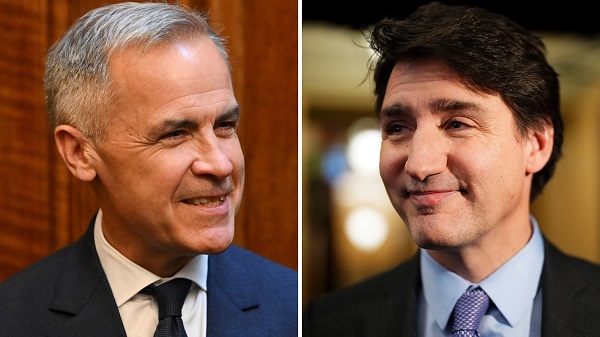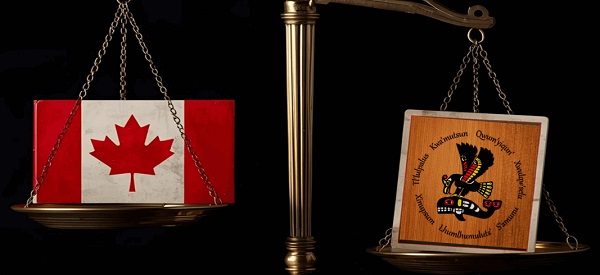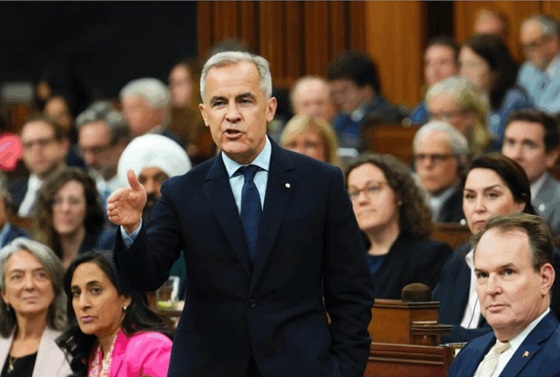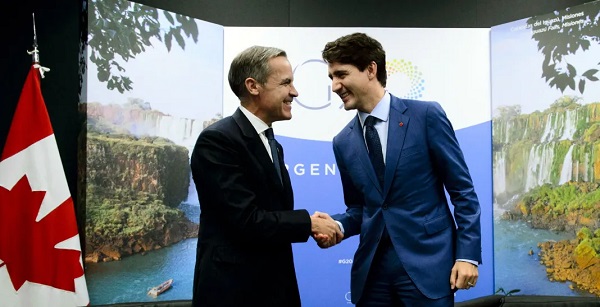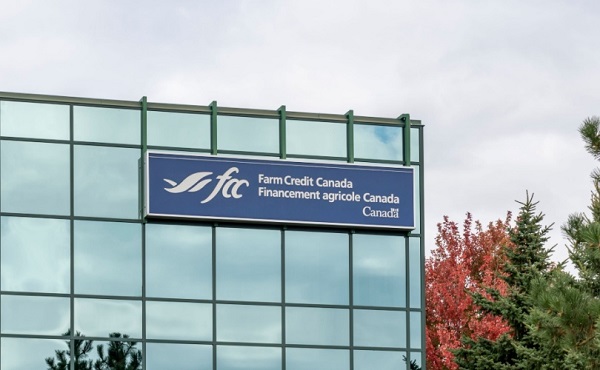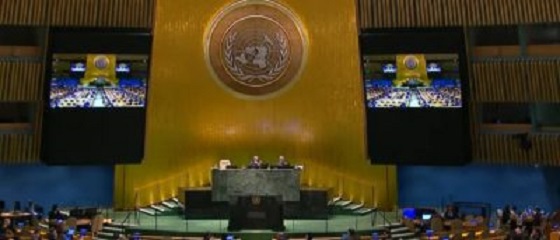Canadian society has evolved since 1867, but the basic outline of our national political institutions has not. As was the case in 1867, these institutions still lack the capacity to accommodate regional circumstances and regional equality.
—Donald J. Savoie, Democracy in Canada: The Disintegration of Our Institutions
The winter 2022 truckers’ protest against Prime Minister Justin Trudeau’s punitive vaccine mandates that shook Canada to its foundations no longer dominates the headlines. But it remains in public consciousness. Prominent protest members were recently convicted or are still on trial. Its implications are still with us and its long-term effects may well be seismic. The Freedom Convoy traversed the country from Prince Rupert, British Columbia to the nation’s capital in Ottawa to protest the biggest experiment ever in authoritarian rule over Canadians. The truckers and their fellow convoy travellers demanded the attention of a disgraceful prime minister, the abolition of the vaccine mandates, and the restoration of the tenets of the Canadian Charter of Rights and Freedoms that had been abused by the prime minister, his cabinet, his bought-and-paid for media mercenaries, and his penchant judiciary.
Writing in C2C Journal, Gwyn Morgan reviews the origins of the event: “Just as the provinces were ending restrictions on the unvaccinated, the Prime Minister proclaimed that returning unvaccinated truckers would be required to ‘quarantine’ for two weeks, a condition that would be impossible to meet.” After two years of dutifully serving their country, Morgan writes, “the truckers were to be thrown out of work – cast aside like unneeded accoutrements.”
 The February 2022 Freedom Convoy sought an audience with the prime minister to push for the reversal of vaccine mandates, but while the protest was entirely peaceful and at times even festive, the truckers faced harsh treatment; many were arrested and some remain in prison today. (Sources of photos: (top left) Emilijaknezevic, licensed under CC BY-SA 4.0; (top right and middle) Maksim Sokolov (Maxergon), licensed under CC BY-SA 4.0; (bottom) Ross Dunn, licensed under CC BY-SA 2.0)
The February 2022 Freedom Convoy sought an audience with the prime minister to push for the reversal of vaccine mandates, but while the protest was entirely peaceful and at times even festive, the truckers faced harsh treatment; many were arrested and some remain in prison today. (Sources of photos: (top left) Emilijaknezevic, licensed under CC BY-SA 4.0; (top right and middle) Maksim Sokolov (Maxergon), licensed under CC BY-SA 4.0; (bottom) Ross Dunn, licensed under CC BY-SA 2.0)
In reaction to official disregard amounting to scorn, vast columns of rigs and trucks “drove along thousands of kilometres of wintery roads to converge upon the nation’s Capital to protest in front of its Parliament buildings. The atmosphere was peaceful, even celebratory. Prime Minister Justin Trudeau refused to meet with the blue-collar truckers, whom he slandered as vandals, racists, misogynists, antisemites, and more,” finally invoking the never-before-used Emergencies Act (successor to the almost-never-used War Measures Act) to crush the protesters.
Two years later, little has changed in Canada. Coming to the defence of a trucker, Jay Vanderwier, who had parked his rig during the protest where police had directed him, who later submitted peacefully to an arrest done unnecessarily at gunpoint, and who was recently convicted of two criminal counts of mischief by a pliable, Liberal-friendly judiciary, former Conservative MP Derek Sloan recalls that when other protesters have come to Ottawa, mainly First Nations officials, “Trudeau would gladly meet them, take a knee, drop the flag to half-mast for months on end, issue endless apologies, and more. But when these honest, hard-working Canadians came to Ottawa, he showed nothing but contempt. [H]e tried to paint them as violent extremists and seditionists.” Though less famous than protesters Tamara Lich, Chris Barber or Pat King, Vanderwier – like other equally unsung protesters – was just as committed, put just as much at risk and has suffered similarly.
 Not a glowing CV: Having “never done what most people would consider a full day’s work in his life,” Justin Trudeau’s pre-office record of achievement featured being a substitute drama teacher and snowboard instructor with an apparent passion for costume parties.
Not a glowing CV: Having “never done what most people would consider a full day’s work in his life,” Justin Trudeau’s pre-office record of achievement featured being a substitute drama teacher and snowboard instructor with an apparent passion for costume parties.
And Trudeau is still on the warpath. This is a prime minister, says former Calgary Herald editor David Marsden with considerable justification, who has “never done what most people would consider a full day’s work in his life.” He certainly never sat in the cab of a semi. He certainly never raised cattle, worked on a farm, hauled timber, fished the rivers, or risked his life on an oil rig. He never tried to start a restaurant or open a business. He’s never had to meet a payroll when money was tight, or negotiate with investors and creditors. He has never excelled in any professional capacity. He has never brought a new product to market, or sold anything except his own brand. The son of a former prime minister and the beneficiary of a family trust, he did a stint of substitute teaching and was a snowboard instructor. Not a glowing CV.
“The prime minister doesn’t like Alberta,” Marsden continues, “His government policies have been designed to bring the province to its knees. He swallowed the Pollyanna spittle [about green energy saving the world] being peddled by his environment minister,” the ineffable Steven Guilbeault who, along with deputy prime minister Chrystia Freeland, is part of the figurative three-headed Cerberus that guards the gates of Canada’s political underworld.
Disdainful of the hardworking, energetic and still somewhat rural-based West, Trudeau, a gilt-edged Laurentian aristocrat, represents precisely what the problem is with this country. We might say that he and his fellow aristocrats are the ‘first cause’ of the truckers’ revolt, which he has done everything in his power to malign and punish.
In essence, Trudeau is the perfect exemplar of the Eastern anointed class, the so-called Laurentian Elite (or Laurentian Consensus), a term coined in its modern sense a dozen years ago by John Ibbitson in the Literary Review of Canada and elaborated in his book, The Big Shift, co-authored with Darrell Bricker. Defined as “the political, academic, cultural, media and business elites” of central-east Canada, the term draws upon the much older “Laurentian School” of thought concerning Canada’s founding structure and originating purpose developed by mainstream (Eastern Canadian) historians like Donald Creighton. Ibbitson floated an early and rather exaggerated conviction of Laurentian collapse at a time when Justin Trudeau was a Liberal apparition planning his triumphal future and that of his Laurentian cohorts. Interestingly, The Big Shift was reprinted in 2014. One year later Trudeau swept into power, completely invalidating the book’s thesis.
Ibbitson is a parenthetical figure, a Globe and Mail journalist, whose relevance resides in the useful neologism he provided and in his status as a representative and influential Laurentian himself, as essay and book make clear. Ibbitson acknowledged that the Western provinces had been treated as “semi-colonial possessions” rather than equal members in Confederation. But he thought all had changed. “The West is in,” Ibbitson declared. “In fact, it is in charge.” This was his assessment of the effect of Stephen Harper’s Conservative government – which has proven utterly ephemeral. Harper may have been “Canada’s First Post-Laurentian Prime Minister”, as claimed in this journal, but it was not to last. Under Trudeau, the West is as out as it’s ever been. And the country as a political entity is less Canadian than it’s ever been. The Laurentian cabal lords over us still, dominant and unaccommodating.
 “The West is in,” declared Toronto Globe and Mail columnist John Ibbitson in The Big Shift; his thesis proved to be premature, exaggerated and even invalid after Trudeau came to power, re-establishing the Laurentian approach to national governance.
“The West is in,” declared Toronto Globe and Mail columnist John Ibbitson in The Big Shift; his thesis proved to be premature, exaggerated and even invalid after Trudeau came to power, re-establishing the Laurentian approach to national governance.
Writing in the National Post, John Weissenberger has no doubt of the fact. “The Laurentian Elite were Upper Canadian Anglo-Protestants and Québécois Patricians, and their descendants still dominate the upper strata of politics, the bureaucracy, Crown corporations and agencies, academia and media,” the Montreal-born Alberta geologist wrote. The current generation of Laurentians, he notes, “Largely reflect the universal, broadly-leftist monoculture.” They are with us like a dirty shirt. Their “torpor and complacency,” however, “coupled with an increasingly arrogant detachment from many ordinary Canadians, particularly those outside central Canada, caused repeated social and political rifts.” The truckers’ protest was among the most physical of these – and could prove the most momentous.
Disdainful of the hardworking, energetic and still somewhat rural-based West, Trudeau, a gilt-edged Laurentian aristocrat, represents precisely what the problem is with this country. We might say that he and his fellow aristocrats are the “first cause” of the truckers’ revolt, which he has done everything in his power to malign and punish. Absent Trudeau and his nasty, ill-advised and unnecessary Covid-19 policies, the trucks would never have rolled.
Louis Riel Would Have Understood the Truckers
To properly understand the truckers’ opposition to the Trudeau Liberals’ vaccine mandate, we need to go back to Canada’s beginnings. The British North America Act of 1867 (later renamed the Constitution Act, 1867) recognized a self-governing Dominion comprising a rump Quebec and Ontario and the Maritime provinces of Nova Scotia and New Brunswick. What was known as Rupert’s Land covered the vast extent of the interior landmass, including what later became Manitoba (1870) and Saskatchewan (1905). Alberta (1905) was carved out from both Rupert’s Land and the adjacent North-Western Territory.
The administrative core of the new country, however, was found in the centre-east with its capital in the backwater town of Ottawa. As we have seen, what came to be known as the Laurentian Compact exercised political and economic control of the fledgling nation and, as noted, remains the administrative, political and financial power-centre to this day.
 In 1867, the newly created, self-governing Dominion of Canada included several provinces, soon followed by the purchase of Rupert’s Land (left map), parts of which later became the second-class provinces of Manitoba, Saskatchewan and Alberta; political and economic control over the young nation rested in the hands of the Laurentian Compact, the elite based in the St. Lawrence River watershed (right map). (Source of maps: (left) Golbez, licensed under CC BY 2.5; (right) Kmusser, licensed under CC BY-SA 2.5)
In 1867, the newly created, self-governing Dominion of Canada included several provinces, soon followed by the purchase of Rupert’s Land (left map), parts of which later became the second-class provinces of Manitoba, Saskatchewan and Alberta; political and economic control over the young nation rested in the hands of the Laurentian Compact, the elite based in the St. Lawrence River watershed (right map). (Source of maps: (left) Golbez, licensed under CC BY 2.5; (right) Kmusser, licensed under CC BY-SA 2.5)
To understand in yet greater detail the gravamen of the truckers’ protest, one must return specifically to the period between 1869 and 1885. These years saw the Red River Rebellion and the subsequent North-West Rebellion, studied in meticulous, close-packed detail in George Stanley’s magisterial The Birth of Western Canada: A History of the Riel Rebellions and Tom Flanagan’s illuminating essay in The Dorchester Review.
When the newly installed Canadian federal government took formal control of Rupert’s Land in 1870, it did not consult with the indigenous Métis, aka the Bois-Brûlé population (children of the union between First Nations women and French and English trappers). Local resentment at being passed over led eventually, under the leadership of Louis Riel, to a Métis uprising, resulting in the formation of a provisional government for purposes of negotiation with Ottawa regarding terms of entry into the Canadian Confederation.
This initiative did not work out well and the Métis did not flourish under the new dispensation. In the course of time a large proportion of Métis lost title to their land, which ultimately contributed to the bloody North-West Resistance of 1885, culminating in the total victory of the federal government, a string of executions including that of Riel, and the further deterioration of relations between the Prairie West and central Canada, which continues to this day. There were, of course, atrocities on both sides, but there is no doubt that the Métis got the short end of the stick.
 Canada’s newly established federal government failed to consult with the Métis population of Rupert’s Land, which triggered an uprising under Louis Riel (left) and eventually the bloody North-West Resistance, which was crushed by federal troops. Shown at right, the Battle of Batoche during the North-West Rebellion. (Source of left photo: Manitoba Historical Society Archives)
Canada’s newly established federal government failed to consult with the Métis population of Rupert’s Land, which triggered an uprising under Louis Riel (left) and eventually the bloody North-West Resistance, which was crushed by federal troops. Shown at right, the Battle of Batoche during the North-West Rebellion. (Source of left photo: Manitoba Historical Society Archives)
In his 1954 book Social Credit and Federal Power in Canada, political scientist James Mallory described the Prairie additions as “provinces in the Roman sense.” (According to the Oxford Classical Dictionary, the origin of the term is obscure, “mistakenly derived from pro + vincere [vanquished] by Roman antiquarians. Its basic meaning is the sphere in which a magistrate is to function.” In his recent C2C essay on Alberta’s future, University of Calgary professor Barry Cooper went with the more martial version of the disputed etymology.) In our terms, the Prairie provinces were regions dominated by the ruling, administrative centre to whom they owed fealty and paid tribute. Parsing Mallory, Cooper explains: “Ottawa acted as a new Rome on the Rideau. The territories (and soon-to-be second-class provinces)…existed to strengthen and benefit Laurentian Canada by analogy with Roman Italy, and to enrich its leading citizens.”
‘We desire, and all Canadian Patriots desire,’ stated Sifton, ‘that the great trade of the prairies shall go to enrich our people to the East, to build up our factories and our places of work, and in every legitimate way to our prosperity.’
Here we must refer to the record of the influential Sir Clifford Sifton in the years 1895-1905. As J.W. Dafoe writes in his biography, CLIFFORD SIFTON in Relation to HIS TIMES, Sifton was a major figure in early Canadian affairs, joining Wilfrid Laurier’s Liberal government in 1896. He became federal Minister of the Interior and Superintendent General of Indian Affairs, responsible for immigration and settlement of the Prairies. Under his leadership, immigration to the Prairie West increased from 16,835 in 1896 to 141,465 in 1905. Against attacks by English-speaking Canadians who feared that immigrants from eastern and central Europe would be a threat to their culture and livelihood, Sifton famously defended the “stalwart peasants in sheep-skin coats” who were turning some of the most difficult areas of the West into productive farms. Sifton touted the phrase the “Last Best West” to market the Canadian Prairies to prospective immigrants.
But there was another side to Sifton which also needs to be conceded. According to the Alberta Prosperity Project, Alberta and the Prairie West have gotten a raw deal from the central establishment since their inception as part of the Dominion. The editors quote Sifton’s speech to Parliament during its 1904 session: “We desire, and all Canadian Patriots desire, that the great trade of the prairies shall go to enrich our people to the East, to build up our factories and our places of work, and in every legitimate way to our prosperity.” As former military engineer and warrant officer Tex Leugner commented in the Cochrane Eagle, “Note the phrase ‘to enrich our own people in the East’! How prophetic Sifton was in laying the groundwork for the theft that has gone on unabated since 1905.”
 The Laurentian view, crystallized: Sir Clifford Sifton, Minister of the Interior and Superintendent General of Indian Affairs, famously defended the “stalwart peasants in sheep-skin coats” who were used to settle the Prairies and whose trade “shall go to enrich our people to the East.” (Sources of photos: (left) Library and Archives Canada/PA-27943; (right) Library and Archives Canada/C-000681)
The Laurentian view, crystallized: Sir Clifford Sifton, Minister of the Interior and Superintendent General of Indian Affairs, famously defended the “stalwart peasants in sheep-skin coats” who were used to settle the Prairies and whose trade “shall go to enrich our people to the East.” (Sources of photos: (left) Library and Archives Canada/PA-27943; (right) Library and Archives Canada/C-000681)
The question was also examined by Mabel F. Timlin in a paper titled Canada’s Immigration Policy, 1896-1910, printed in the Canadian Journal of Economics and Political Science (Vol. XXVI, No. 4, November 1960, pp. 517-532). Timlin cites Sifton’s letter of April 15, 1901 to Laurier in which Sifton advocates the importance of “encouraging immigration for the development of natural resources and the increase in production of wealth from these resources.” The wealth so generated comes to rest mainly in the coffers and consortiums of the East. The intimation is disturbing. Sifton was a man of the West, the de facto founder of the province of Manitoba. At the same time, he was also a man of the East, working to enrich its power and economic nexus. A veritable Jekyll and Hyde, Sifton is a symbol of a divided Canada, a country that has not yet decided what it wants to be.
The Modern-Day Laurentian Economic Model
Commenting on the present imbroglio in which the country finds itself, Leugner takes issue with Laurentian profiteering and self-aggrandizement specifically in the form of Canada’s so-called “Equalization” program. The federal government describes it as a means “for addressing fiscal disparities among provinces”; equalization works by indirectly transferring revenues drawn from the taxpayers of more-productive and higher-income provinces to less prosperous provincial governments.
The Prairies are Canada’s food and energy breadbasket and have suffered under the rule of Eastern Canada’s Laurentian peerage, more recently with former Prime Minister Pierre Trudeau’s low-pricing, high-taxing National Energy Program (NEP) in 1980, which devastated Alberta’s oil industry and entire economy.
One can see the intrinsic problem for a country where some jurisdictions perennially lag and others consistently out-perform. Alberta’s average equalization contribution is substantially over-leveraged. According to the Canadian Taxpayers Federation, equalization has cost Alberta taxpayers $67 billion since its inception in 1957, making the cost of equalization per Albertan $20,200 since 1957; in 2021, equalization overall cost Alberta taxpayers $2.9 billion. The Fraser Institute pegs the 2017 net outflow at $3.1 billion. Estimates may vary but remain within the same ballpark.
 Since the inception of Canada’s equalization program in 1957, Alberta has made a net contribution of $67 billion – which in turn represents only a small part of the province’s immense financial contribution to federal coffers and the governments and residents of other provinces.
Since the inception of Canada’s equalization program in 1957, Alberta has made a net contribution of $67 billion – which in turn represents only a small part of the province’s immense financial contribution to federal coffers and the governments and residents of other provinces.
Even more significantly, the Fraser Institute notes that the equalization drain represents “just a small part of the province’s outsized contribution to confederation in recent years.” It calculates that “the gap between Albertans’ contribution to federal revenues and federal expenditures plus transfers to the province, totalled $20.5 billion annually in 2017/18. And this measure excludes Albertans’ disproportionate cumulative contribution to the Canada Pension Plan, which on net totalled $2.9 billion in 2017.”
Meanwhile, as Alberta is being plundered, Justin Trudeau, like his father Pierre, is doing everything in his power to eviscerate Alberta’s energy industry, the source of its prosperity and of Canada’s solvency. Indeed, the recently completed Trans Mountain Pipeline expansion, shipping oil at last after a horrendous nearly 15-year gestation, is slated to contribute 0.25 percent to Canada’s GDP growth next year – more, indeed, than the entire province of B.C. Leugner concludes, despairingly: “It is my opinion that Canada, as it’s currently structured, is a broken nation.” This from a veteran, much-deployed officer in the Canadian military.
 “The province that carries most of the weight, bears the most pain”: Alberta’s oil and natural gas industry and entire economy were devastated by the taxes and regulations of Pierre Trudeau’s (top) 1980 National Energy Program; today Alberta’s burden is amplified by the younger Trudeau’s onerous carbon tax. Shown at bottom, a pro-pipeline demonstration in Calgary, Alberta. (Source of bottom photo: The Canadian Press/Jeff McIntosh)
“The province that carries most of the weight, bears the most pain”: Alberta’s oil and natural gas industry and entire economy were devastated by the taxes and regulations of Pierre Trudeau’s (top) 1980 National Energy Program; today Alberta’s burden is amplified by the younger Trudeau’s onerous carbon tax. Shown at bottom, a pro-pipeline demonstration in Calgary, Alberta. (Source of bottom photo: The Canadian Press/Jeff McIntosh)
The Prairies are Canada’s food and energy breadbasket and have suffered under the rule of Eastern Canada’s Laurentian peerage, particularly with former Prime Minister Pierre Trudeau’s low-pricing, high-taxing National Energy Program (NEP) in 1980, which devastated Alberta’s oil industry and entire economy. Justin Trudeau is picking up where his father left off, slapping an onerous carbon tax on the nation that has already pulverized the national economy and has proved especially costly to Prairie agriculture and energy production. As the late Rex Murphy wrote in the National Post, Alberta is “the province that carries most of the weight, bears the most pain and has the least say in this mad enterprise.”
The tax, Murphy continued, will “injure the very farmers who have been stocking the supermarket shelves during COVID, put oil workers (at least those who still have jobs) out of work, and increase the cost of living for everyone…This new carbon tax will throw a spike in the heart of the oil and gas industry. Keep in mind that it is but the most recent in a long string of policies designed to hamstring the industry, block its exports and drive investment out of the province.”
The Enduring Meaning of the Truckers’ Protest
Section 92A [of the Constitution Act] confirms the constitutional foundation for provincial natural resource management and a significant role in natural resource trade and anchors Alberta’s energy resource economic strength. This is Peter Lougheed’s economic legacy for Alberta.
This is how we need to understand the truckers’ massive 2022 protest, nominally a form of domestic resistance against the vaccine mandates that crippled their health and their livelihoods, as it did the nation in large. But it is fundamentally an expression of the greater historical context of Eastern political, legislative and market domination of the Western provinciae and the determined response of a long misprized, undervalued and misrepresented sector of the nation, rising up against the metaphorical equivalent of the federal government’s 1885 land grab.
Resistance is continuing to mount. The province of Saskatchewan has refused to pay the federal government’s carbon levy and has just been granted an injunction to stop the Canada Revenue Agency from simply garnisheeing the (mounting) outstanding sum. Alberta Premier Danielle Smith’s UCP government introduced and quickly passed the Alberta Sovereignty Within a United Canada Act in response to proposed federal net-zero electricity grid regulations and other recurring intrusions on the province’s core jurisdictions. “We are left with no choice but to create a shield to protect Albertans from Ottawa’s dangerous and unconstitutional electricity regulations,” Smith said at the time. She has also proposed an Alberta Crown Corporation that would be wholly owned by the province and over which the federal government could exert no control, which would function as a market generator.
 To defend against the federal government’s ongoing intrusions on Alberta’s constitutional jurisdiction, Danielle Smith’s (top) UCP government passed the Alberta Sovereignty Within a United Canada Act – a “shield to protect Albertans from Ottawa’s dangerous and unconstitutional electricity regulation.” Shown at bottom, supporters of the Sovereignty Act gather in Edmonton, Alberta, December 2022. (Sources of photos: (top) Alberta Newsroom, licensed under CC BY-NC-ND 2.0; (bottom) Caleb Perreaux/CBC)
To defend against the federal government’s ongoing intrusions on Alberta’s constitutional jurisdiction, Danielle Smith’s (top) UCP government passed the Alberta Sovereignty Within a United Canada Act – a “shield to protect Albertans from Ottawa’s dangerous and unconstitutional electricity regulation.” Shown at bottom, supporters of the Sovereignty Act gather in Edmonton, Alberta, December 2022. (Sources of photos: (top) Alberta Newsroom, licensed under CC BY-NC-ND 2.0; (bottom) Caleb Perreaux/CBC)
As to be expected, the Sovereignty Act has been denounced by all the usual Laurentian suspects and Liberal toadies: the CBC, The Globe and Mail, the Toronto Star and many others. No matter. The aforementioned Barry Cooper places Alberta’s Sovereignty Act in the context of the Prairie provinces’ long struggle for due constitutional recognition and the political equality of their citizens. And he is right. The germ of the issue goes back to the unequal founding of Canada as a Confederation and is now culminating in manifestations like the Freedom Convoy and its consequences, Saskatchewan’s defiance of Trudeau’s carbon tax and Alberta’s long-deferred Sovereignty Act.
 The truckers’ Freedom Convoy was not just a desperate response to the Trudeau government’s ruinous vaccine mandate but, the author believes, a historically significant attempt to restore the political balance between Eastern and Western Canada. (Source of photo: Maksim Sokolov (Maxergon), licensed under CC BY-SA 4.0)
The truckers’ Freedom Convoy was not just a desperate response to the Trudeau government’s ruinous vaccine mandate but, the author believes, a historically significant attempt to restore the political balance between Eastern and Western Canada. (Source of photo: Maksim Sokolov (Maxergon), licensed under CC BY-SA 4.0)
The Canadian Constitution establishes that the federal Parliament deals mainly with issues that concern the country as a whole, including inter-provincial trade, national defence, criminal law, money, patents, and the postal service, whereas the provinces have the authority to make laws about education, property, civil rights, the administration of justice, hospitals, municipalities, and other local or private matters. Lands and resources within or lying beneath provinces are also clearly-stated areas of provincial jurisdiction and ownership. Pointedly, “Crown” lands are almost always owned by the Crown in right of the province within which they fall.
The federal government has no business intruding on the rights of the provincial domain as guaranteed by the Constitution. But under Trudeau the Younger, that is virtually all it does. Ottawa has gone even further in moving to centralize political control in the Prime Minister’s Office rather than respecting provincial jurisdiction.
The truckers’ response to the federal usurpation of plenary authority under cover of a pandemic was in the last analysis an attempt to right the political, economic and administrative balance between Eastern and Western Canada. Laurentian hegemony had to be cut down to size, and though it appeared that the federal power had once again – as in the 1885 hecatomb of the Prairie rebels – won the day, routing the truckers, confiscating vehicles, freezing bank accounts, imprisoning its leaders and mobilizing the legacy media to blanket the nation with lies, the aftermath was an awakened and defiant Western Canada, an almost universally hated prime minister, a Liberal party on the ropes, and a gradual vindication of the Truckers’ bravery and suffering in an honourable and democratic cause.
Justice is now Being Served
Let not my people be held at ransom.
Let them thrive, let them be defended.
—Louis Riel, from Selected Poetry of Louis Riel
“The North-West Rebellion was far more important in its results than in itself,” wrote the aforementioned George Stanley in The Birth of Western Canada. The truckers’ descent upon Ottawa is one of those later results of the Red River Rebellion that Stanley had considered to be of enduring significance. The analogy suggested by the reliable trucker supply chain over the years and during the pandemic, namely, of the West feeding the East with comestibles, goods and energy, should have been obvious to any observant person. Justice is now being served. The protest inspired confidence in its purpose, exposed the federal government as an authoritarian leviathan, and led to the responses that we are witnessing in Alberta and Saskatchewan.
Should the respective powers and responsibilities of federal and provincial authority be clarified and genuinely ratified, should a fair distribution of obligations and prerogatives between Ottawa and the Western capitals be arrived at, the truckers may yet have saved the country from its downward spiral.
At this historic juncture, the Laurentian elite must agree to terms and make peace with the Prairie West if both are to become true partners in a renovated Confederation. At the moment, the most important city in Canada is not to be found in the Laurentian triangle of Toronto, Montreal and Ottawa. Despite its current problems with an unpopular mayor and a compromised infrastructure, the most important city in Canada today is Calgary, not only the home of the world-famous Calgary Stampede, but also “the epicenter of the energy industry in Canada with head offices of every major company…located in the city,” as an upcoming global energy conference describes it.
 The nation’s most important city, the author argues, is not Ottawa, Toronto or Montreal, but Calgary – home of the world-famous Calgary Stampede and “the epicenter of the energy industry in Canada with head offices of every major company.” (Sources of photos (clockwise starting top-left): micha_dauber, licensed under CC BY-NC-SA 2.0; Gnosis, licensed under CC BY-SA 4.0; Ron Cogswell from Arlington, Virginia, USA, licensed under CC BY 2.0; JHVEPhoto/Shutterstock)
The nation’s most important city, the author argues, is not Ottawa, Toronto or Montreal, but Calgary – home of the world-famous Calgary Stampede and “the epicenter of the energy industry in Canada with head offices of every major company.” (Sources of photos (clockwise starting top-left): micha_dauber, licensed under CC BY-NC-SA 2.0; Gnosis, licensed under CC BY-SA 4.0; Ron Cogswell from Arlington, Virginia, USA, licensed under CC BY 2.0; JHVEPhoto/Shutterstock)
The irony is exquisite. Should the respective powers and responsibilities of federal and provincial authority be clarified and genuinely ratified, should a fair distribution of obligations and prerogatives between Ottawa and the Western capitals be arrived at, the truckers may yet have saved the country from its downward spiral and helped to create the just and equable Canada that it should have been from the beginning. As the above-quoted Savoie writes in Democracy in Canada, “Canada was born to break the political deadlock between Canada West and Canada East.”
It was a long road from Prince Rupert to Ottawa, but a road, as it turns out, that had to be travelled.
David Solway’s latest prose book is Crossing the Jordan: On Judaism, Islam, and the West (New English Review Press, 2023). A new poetry chapbook, From the Sommelier’s Notebook, was released in July 2024 (Little Nightingale Press). Solway has produced two CDs of original songs: Blood Guitar and Other Tales (2014) and Partial to Cain (2019) on which he is accompanied by his pianist wife Janice Fiamengo. A third CD, The Dark, is in planning.



